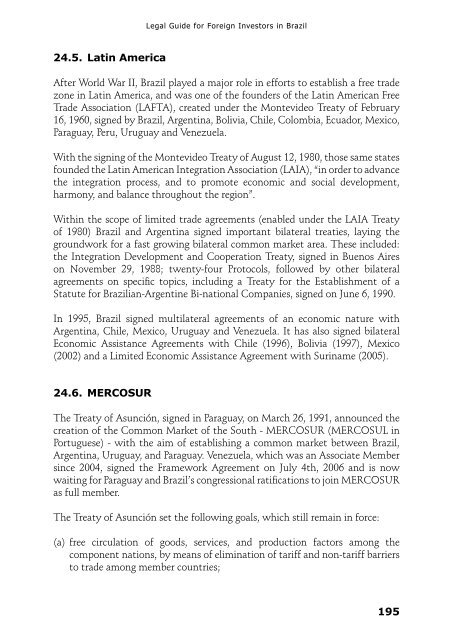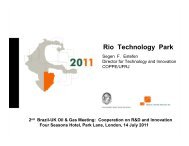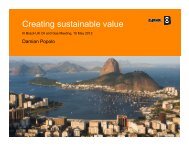Legal Guide for Foreign Investors in Brazil - Apex-Brasil
Legal Guide for Foreign Investors in Brazil - Apex-Brasil
Legal Guide for Foreign Investors in Brazil - Apex-Brasil
You also want an ePaper? Increase the reach of your titles
YUMPU automatically turns print PDFs into web optimized ePapers that Google loves.
<strong>Legal</strong> <strong>Guide</strong> <strong>for</strong> <strong>Foreign</strong> <strong>Investors</strong> <strong>in</strong> <strong>Brazil</strong><br />
24.5. Lat<strong>in</strong> America<br />
After World War II, <strong>Brazil</strong> played a major role <strong>in</strong> ef<strong>for</strong>ts to establish a free trade<br />
zone <strong>in</strong> Lat<strong>in</strong> America, and was one of the founders of the Lat<strong>in</strong> American Free<br />
Trade Association (LAFTA), created under the Montevideo Treaty of February<br />
16, 1960, signed by <strong>Brazil</strong>, Argent<strong>in</strong>a, Bolivia, Chile, Colombia, Ecuador, Mexico,<br />
Paraguay, Peru, Uruguay and Venezuela.<br />
With the sign<strong>in</strong>g of the Montevideo Treaty of August 12, 1980, those same states<br />
founded the Lat<strong>in</strong> American Integration Association (LAIA), “<strong>in</strong> order to advance<br />
the <strong>in</strong>tegration process, and to promote economic and social development,<br />
harmony, and balance throughout the region”.<br />
With<strong>in</strong> the scope of limited trade agreements (enabled under the LAIA Treaty<br />
of 1980) <strong>Brazil</strong> and Argent<strong>in</strong>a signed important bilateral treaties, lay<strong>in</strong>g the<br />
groundwork <strong>for</strong> a fast grow<strong>in</strong>g bilateral common market area. These <strong>in</strong>cluded:<br />
the Integration Development and Cooperation Treaty, signed <strong>in</strong> Buenos Aires<br />
on November 29, 1988; twenty-four Protocols, followed by other bilateral<br />
agreements on specific topics, <strong>in</strong>clud<strong>in</strong>g a Treaty <strong>for</strong> the Establishment of a<br />
Statute <strong>for</strong> <strong>Brazil</strong>ian-Argent<strong>in</strong>e Bi-national Companies, signed on June 6, 1990.<br />
In 1995, <strong>Brazil</strong> signed multilateral agreements of an economic nature with<br />
Argent<strong>in</strong>a, Chile, Mexico, Uruguay and Venezuela. It has also signed bilateral<br />
Economic Assistance Agreements with Chile (1996), Bolivia (1997), Mexico<br />
(2002) and a Limited Economic Assistance Agreement with Sur<strong>in</strong>ame (2005).<br />
24.6. MERCOSUR<br />
The Treaty of Asunción, signed <strong>in</strong> Paraguay, on March 26, 1991, announced the<br />
creation of the Common Market of the South - MERCOSUR (MERCOSUL <strong>in</strong><br />
Portuguese) - with the aim of establish<strong>in</strong>g a common market between <strong>Brazil</strong>,<br />
Argent<strong>in</strong>a, Uruguay, and Paraguay. Venezuela, which was an Associate Member<br />
s<strong>in</strong>ce 2004, signed the Framework Agreement on July 4th, 2006 and is now<br />
wait<strong>in</strong>g <strong>for</strong> Paraguay and <strong>Brazil</strong>’s congressional ratifications to jo<strong>in</strong> MERCOSUR<br />
as full member.<br />
The Treaty of Asunción set the follow<strong>in</strong>g goals, which still rema<strong>in</strong> <strong>in</strong> <strong>for</strong>ce:<br />
(a) free circulation of goods, services, and production factors among the<br />
component nations, by means of elim<strong>in</strong>ation of tariff and non-tariff barriers<br />
to trade among member countries;<br />
195









